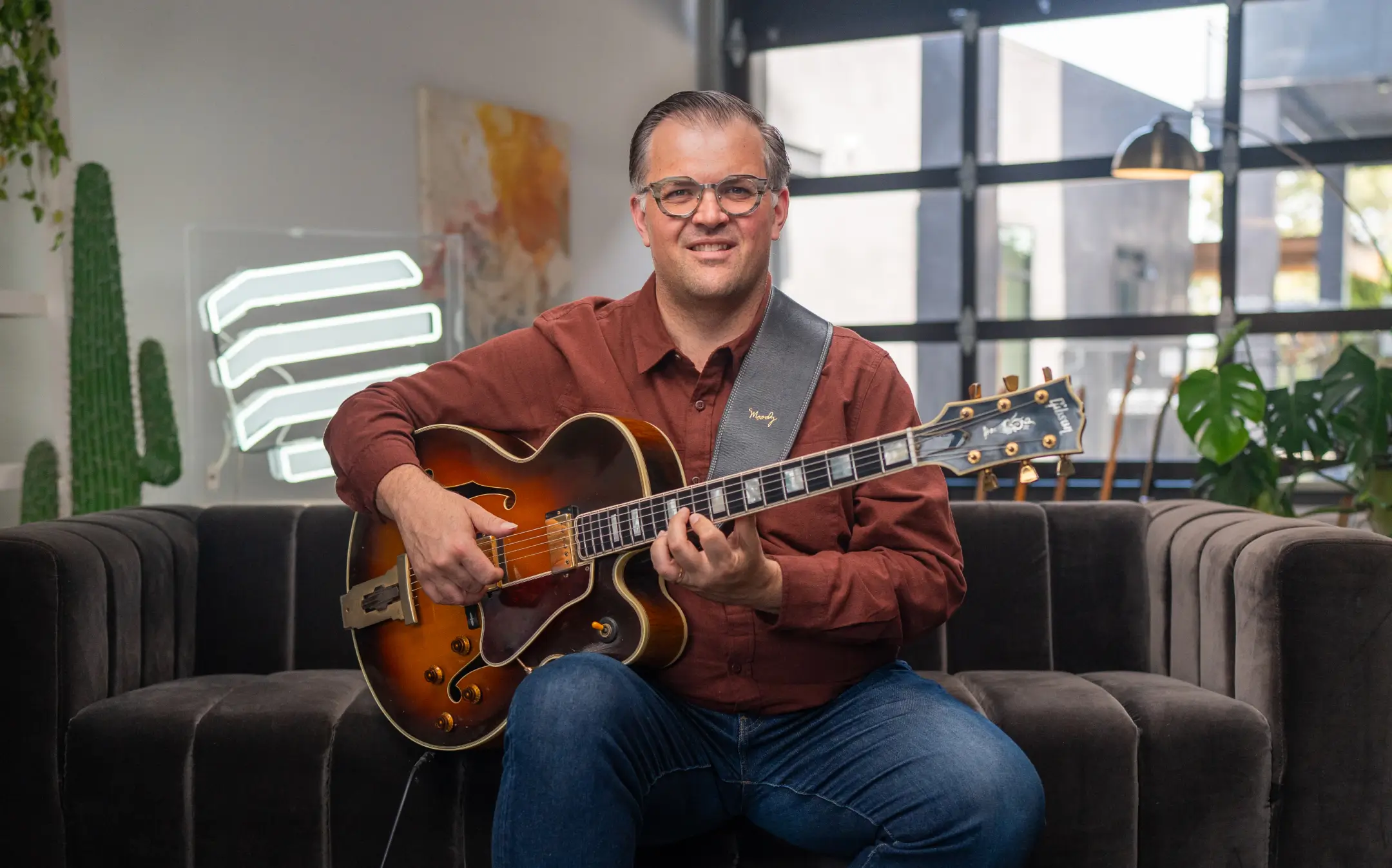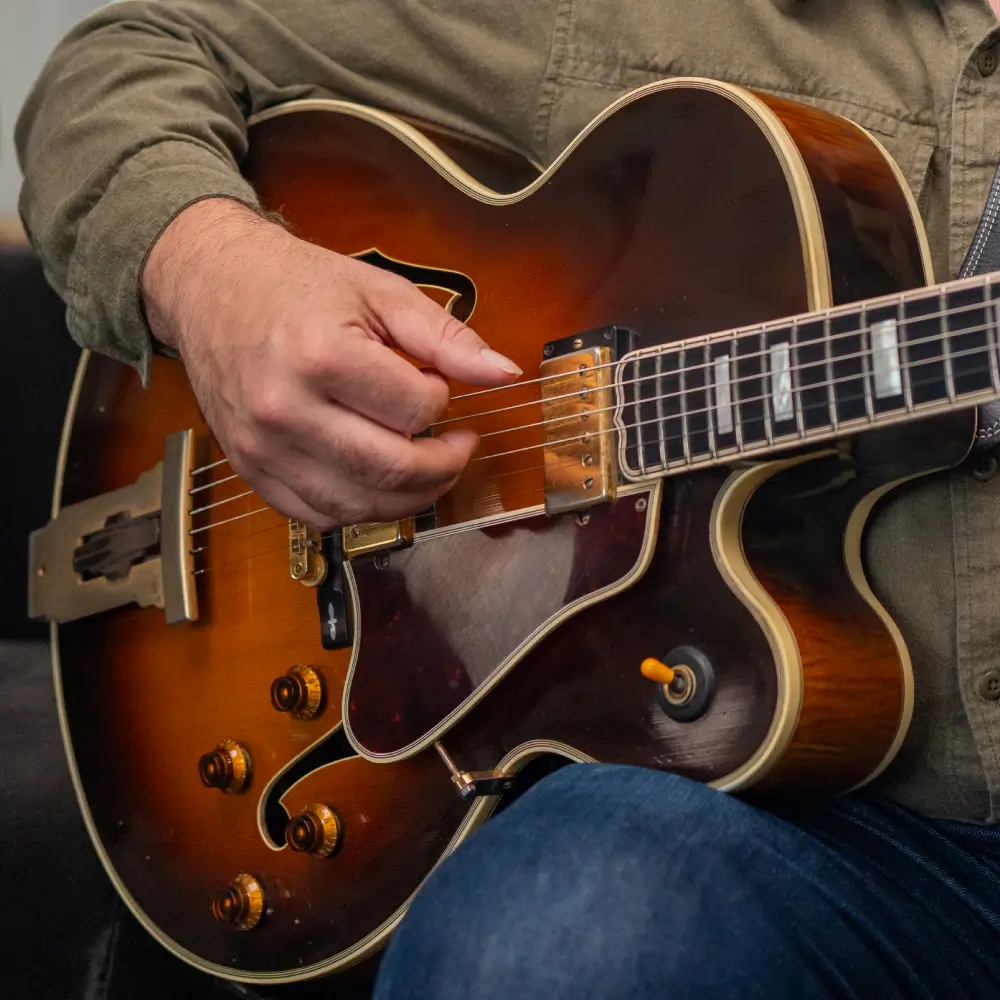Jazz Learning Pathway
Learn the language of jazz guitar.
Intermediate guitarists
You don’t need to be a theory expert to play jazz. We’ll take your foundation and teach you how to play like an authentic jazz guitarist.
3 months
John will guide you through 6 grades of step-by-step instruction with daily practice plans and assessments.
Find your voice
You’ll leave this Learning Pathway with a solid base of jazz fundamentals the freedom to express yourself through it.
Take the next step
Keep your momentum going with advanced classes and guided pathways to push your playing further.
What you'll learn
Intimidated by the world of jazz? We've got your back. Join John as he teaches you how build authentic jazz vocabulary without getting lost in the complexity that turns most players away.
- Demystify the art of comping
- Learn to think like a jazz musician
- Level up your soloing by 'playing the changes'
- Use practical theory to improve your playing in any style

Curriculum
Stay focused with this step-by-step learning program designed by our expert team of music educators.
Your guided Learning Pathway
In this 3-month Learning Pathway, John Storie will help you develop a college-level command of jazz guitar. You’ll leave this class ready to comp, solo, and play authentically in any jazz setting.

Intro to Jazz Guitar
Every great jazz guitarist started somewhere. This class is your launch pad to advanced playing.
You'll kick off your jazz journey with John by building the harmonic and rhythmic foundation that defines the genre.
Across 7 guided lesson days, you’ll explore the core pillars of jazz, rhythm fundamentals, and basic melodic ideas, all while learning how to think like a jazz musician.

Chord-Scale Relationships
Chords and scales are cut from the same cloth.
In this grade, you’ll learn how they connect across the fretboard so you can outline ii-V-I progressions and start thinking like an improviser.

Comping
A great jazz guitarist makes the whole band feel better, and that’s what comping is all about.
This grade teaches you how to groove, shape harmony in real time, and communicate with the rhythm section... AKA all of the skills that make other musicians want to play with you.
Grade 4. Improvisation
Improvisation is where you stop sounding like a student and start sounding like you. In this grade, you’ll learn to build real jazz lines, not by memorizing licks, but by understanding how melody follows harmony through the most common progressions in jazz
Grade 5. Melody
This grade is all about learning melodies the way jazz guitarists actually do: straight from standards. You’ll study how melodies connect to chord changes, how to play them with feel, and how they shape your solos and chord melody playing.
Grade 6. Learning Jazz Standards
Everything you’ve learned so far leads here. In this grade, you'll dive into the time-honored tradition of learning standards. You'll nail the melody, comp the changes, and take a solo to cap off the pathway like a true jazz guitarist.
Grade 1. Intro to Jazz Guitar
Start your journey by learning the absolute fundamentals of what it takes to become a certified jazz cat. You’ll get familiar with foundational jazz skills and concepts, like shell voicings, chord melody, jazz rhythms, and more.
Day 1. Jazz guitar roles
The first step on your jazz journey is understanding the three roles that jazz guitarists fill in a band: comping chords, playing melodies, and improvising solos. Often, you’ll take on these roles in the same song. This lesson will introduce you to these roles and prepare you for the rest of the class.
Day 2. Chord-scale relationships
Understanding how chords and scales connect will give you a cheat sheet for matching melodic and lead ideas to the underlying harmony. If you’ve ever wondered what “playing the changes” means, this lesson will start to demystify the process so you can leave randomness behind in your solos.
Day 3. Jazz rhythm
What sets jazz apart from other genres? Short answer: its unique rhythms. In this lesson, you’ll learn how to feel the beating heart of jazz through syncopation, common rhythms, and the swing feel.
Day 4. Blues to jazz
The blues and jazz are intricately connected. Learning the 12-bar blues form will unlock thousands of standards and give you a strong foundation for comping and improvising using the blues scale.
Day 5. Shell chords
From comping to chord melodies, shell voicings are the jazz guitarist's secret weapon. Made up of the root, 3rd and 7th, shell chords include only the most essential harmonic information. You’ll learn how to apply these pared-down voicings to the standard After You’ve Gone.
Day 6. Call and response
Jazz is perhaps the most conversational genre, and throughout a song you should be listening and responding to what the other musicians on stage with you are doing. The concept of call and response lets you make your playing more intentional and unique to your voice.
Day 7. Chord melody
Whether you’re playing in a band or on your own, the guitar lets you blend chords and melody seamlessly to perform an entire jazz standard. For this lesson, we’re taking inspiration from the king of chord melodies: Joe Pass.
Performance pieces
Choose a song to learn that takes what you worked on in Grade 1 and puts it in a musical context. Here, you'll get to jam with a live-recorded band of professional L.A. musicians as your backing track.
Personalized feedback
Submit a video of yourself playing a performance piece from this grade for custom video feedback on your playing from our team of pro guitarists.
Final Quiz
Make sure you're ready to move on to Grade 2.
Grade 2. Chord-scale relationships
In this grade, we’re leaving boring scale drills behind and instead diving deeper into the components of jazzy chords and progressions using modes and arpeggios. This is where you’ll start outlining chord changes and creating sophisticated lead lines.
Day 1. The major ii-V-I
In this lesson, John will walk you through using Roman numerals to communicate with other musicians and internalize the core progressions that make up the genre, starting with the most important of all: the major ii-V-I.
Day 2. Major 9 extensions
Build on your basic 7th chords with the 9th. This nostalgic-sounding note adds a subtle and sophisticated flavor to your chords. To keep things from getting muddy, John will introduce you to rootless chords as a way to stay sonically considerate to other musicians in the band.
Day 3. Minor 9 extensions
Now, you’ll learn how to spice up the ii chord by throwing in the minor 9. John will also show you a lick that combines the arpeggio and scale shape to perfectly outline the minor 9 sound.
Day 4. Dominant 9th extensions
Inject some funkiness into your ii-V-I with a G9 chord. You’ll learn how to play over this chord using the Mixolydian scale and the G9 arpeggio.
Day 5. Common ii-V-I comping moves
John’s got a stock rhythmic phrase for you that will ensure you’ll never be at a loss for what to play over a ii-V-I progression ever again. But you’re not just gonna use this phrase without context. You’ll learn how to tune in to the drummer and respond to the groove.
Day 6. Common ii-V-I licks
Now, you’ll shift focus to build some ii-V-I licks that highlight each of the chords. These licks are pre-made phrases that you can pull out to play over a ii-V-I progression instead of trying to improvise over everything.
Day 7. Major ii-V-I workout
Put on your workout fedora because we’re hitting the Jazz Gym with a workout that will lock in your comping and lick phrases.
Performance pieces
Choose a song to learn that takes what you worked on in Grade 2 and puts it in a musical context. Here, you'll get to jam with a live-recorded band of professional L.A. musicians as your backing track.
Personalized feedback
Submit a video of yourself playing a performance piece from this grade for custom video feedback on your playing from our team of pro guitarists.
Final Quiz
Make sure you're ready to move on to Grade 3.
Grade 3. Comping
Soloing is fun and all, but being able to comp well will make you every musician’s favorite guitarist to play with. By the end of this grade, you’ll have a toolkit of pro-level comping skills that will get you through pretty much any session.
Day 1. Rootless blues voicings
Remember those rootless chords we looked at in the previous grade? Well, they’re back and they’re bluesier than ever. Combine your rootless voicings with the Charleston rhythm to swing through a 12-bar blues in Bb.
Day 2. Freddie Green-style comping
Ready for a masterclass in simplicity? Freddie Green set the bar for jazz comping, often paring down rootless voicings to just the 3rd and 7th. We’ll take a page from Green’s book by learning how to comp with jazzy dyads.
Day 3. The half-diminished chord and the minor ii-V-I
You won’t hear the half-diminished chord very frequently in rock, pop, or folk. But it’s everywhere in jazz, especially as the ii chord in the minor ii-V-I progression. Learn how to apply this chord over a traditional bossa rhythm inspired by the standard Blue Bossa.
Day 4. Common V chord alterations
The V chord in a minor ii-V-I is where all the tension is. In this lesson, John will show you how to make this chord even more dramatic with extensions like the b9, #9, and b13.
Day 5. Diminished 7th chords
One of the beautiful things about jazz is that we can sometimes add chords no one asked for. The diminished 7th chord is one of those chords! It’s a passing chord that we can use, for example, between the I and ii chords for voice-leading. John will show you how to play it in multiple positions around the fretboard.
Day 6. Autumn Leaves
In this lesson, John will use the jazz standard Autumn Leaves as an example to help you navigate a song without getting lost in the form (particularly when the melody or singer drops out). Learn the patterns that will help you avoid getting lost when it comes time to solo.
Day 7. Must-know intros and endings
If jazz is a conversation, you don’t want to just jump in at 100%. You want to introduce yourself and offer a hello, then wrap it up with a goodbye that resolves everything. This lesson will give you multiple ideas for beginning and ending songs to create an interesting and productive conversation.
Performance pieces
Choose a song to learn that takes what you worked on in Grade 3 and puts it in a musical context. Here, you'll get to jam with a live-recorded band of professional L.A. musicians as your backing track.
Personalized feedback
Submit a video of yourself playing a performance piece from this grade for custom video feedback on your playing from our team of pro guitarists.
Final Quiz
Make sure you're ready to move on to Grade 4.
Grades 4-6
Learn how to play the changes, master a melody, and get the most out of jazz standards.
Grade 4. Improvisation
Ready to step out and take your solo? Well, by the end of this grade, you will be! With a toolkit of minor scales, bebop techniques, and licks for common progressions, you’ll leave behind memorized scale runs to improvise with confidence.
Day 1. Minor scales explained
With so many possible minor scales to use, it can be overwhelming trying to figure out which to learn. Fortunately, for jazz guitar, you really only need four: Dorian, Aeolian, harmonic minor, and melodic minor. In this lesson, John demystifies these minor scales so you know exactly when and how to use each.
Day 2. The minor ii-V-I
You already know how to comp over major and minor ii-V-I progressions. Now, you’ll learn how to solo over minor chord changes using three modes: Locrian, Phrygian dominant, and Aeolian. If this sounds overwhelming, you can also use the blanket approach with the harmonic minor scale we learned yesterday.
Day 3. Short major and minor ii-V-I
Jazz can move quickly, and you won’t always have the luxury of outlining each chord in a ii-V-I. No need to fear, though! John is here with three different approaches you can take to tackle short ii-V’s. These include the blanket approach, linking arpeggios, and using scales to connect chord tones with step-wise motion. After today, no ii-V-I will be too fast for your mind and fingers.
Day 4. I to III7
With the ii-V-I under your belt, it’s time to look at another common progression using the secondary dominant chord. By replacing the minor iii with a III7, you introduce tension and set up for a possible key change. You’ll learn how to solo over this chord in the key of C using both the blanket approach and the E7 arpeggio.
Day 5. The turnaround
Turnarounds act like a reset button, signaling either the end of a tune or a looping back to the top. You’ll find turnarounds throughout jazz history, and it’s vital to know how to solo over these using several methods. From scales and the blanket approach to arpeggios and certain phrases, you’ll have a variety of options to address this rhythmically fun progression.
Day 6. Minor blues
Back to the blues! Jazz blues progressions often include some interesting chord choices that you might not normally find in a traditional blues. In this lesson, you’ll learn how to comp and solo over a jazzy 12-bar blues that includes a turnaround.
Day 7. Chromaticism and enclosure
What makes a solo jazzy? Two key ingredients are bebop-style chromaticism and enclosing a note. You’ll learn the bebop scale and then make it musical with two licks you can copy and paste into your own lines.
Performance pieces
Choose a song to learn that takes what you worked on in Grade 4 and puts it in a musical context. Here, you'll get to jam with a live-recorded band of professional L.A. musicians as your backing track.
Personalized feedback
Submit a video of yourself playing a performance piece from this grade for custom video feedback on your playing from our team of pro guitarists.
Final Quiz
Make sure you're ready to move on to Grade 5.
Grade 5. Melody
Melodies are the most memorable part of any song. In this grade, you’ll explore strategies for learning the melody to six jazz standards. You’ll then focus on using embellishments to make them unique to your guitar voice.
Day 1. When the Saints
There are many different resources out there that claim they are the definitive version of a melody, but not everything is high quality. Using the classic tune When the Saints Go Marching In as our reference, John presents a 4-step approach to learn a melody. These include listening to the original song if it’s available and referencing a lead sheet or TAB to double check.
Day 2. When the Saints (with embellishments)
Now that you’ve got the melody for When the Saints locked in, it’s time to spice things up with a few soloist techniques. Play the melody up an octave to cut through the band and stand out. Add call and response with a few of your own ideas. Finally, you’ll learn how to add chord stabs and chord melody to blend harmony and melody.
Day 3. Blue Skies
Learn the melody for Irving Berlin’s hit Blue Skies. John will introduce you to three different versions of the song you can listen to on your own to internalize the melody to this classic tune.
Day 4. Pickup, No Chaser (F blues)
We took inspiration from Thelonious Monk’s Straight, No Chaser for this tune. This song is especially vital to learn because it’s in the key of F. Certain keys (like F and Bb) are common in jazz thanks to horn players. Having licks available in the key of F will help you navigate your next jazz session.
Day 5. After You’ve Gone
Following the same process as previous days, you’ll learn the melody for After You’ve Gone. You’ve already learned the chords for this song back in Grade 1, so learning the melody should be much easier.
Day 6. Purple Bossa
Learn John’s take on the melody of Blue Bossa, one section at a time. You’ll focus on seeing the chords as you play through the melody (chord-scale relationships, anyone?!). As a bonus, the melody to Purple Bossa works as a contrafact (fancy word for a new melody over the chord changes of an existing tune) over backing tracks of the original Blue Bossa.
Day 7. Bye Bye Blackbird
This standard is a great example of a memorable melody that uses just a handful of notes. You’ll work on getting the melody in your ear and adding some fancy musical embellishments to make it your own.
Performance pieces
Choose a song to learn that takes what you worked on in Grade 5 and puts it in a musical context. Here, you'll get to jam with a live-recorded band of professional L.A. musicians as your backing track.
Personalized feedback
Submit a video of yourself playing a performance piece from this grade for custom video feedback on your playing from our team of pro guitarists.
Final Quiz
Make sure you're ready to move on to Grade 6.
Grade 6. Learning Jazz Standards
To cap off the class, you’ll combine all the jazz guitar roles to memorize seven real standards. Once you finish this grade, you’ll truly be a well-rounded jazz cat ready for the smoky jazz lounge.
Day 1. Lah-bee-doo (Bb blues)
It’s time to think like a real jazz guitarist. You’ll learn to comp, play the head, and solo over this standard. You’ll have plenty of chances to make the chords and melody your own, as well as to create a solo that responds to the other musicians in the track.
Day 2. Purple Bossa (Blue Bossa)
We’re returning to Rio de Janeiro for some bossa vibes. John’s version includes a few vital jazz concepts to have in your pocket, including the ii-V-I progression in two different keys and arpeggios that use the 9 on the top.
Day 3. When the Saints
This classic tune is often called in jam sessions, so having it memorized will serve you throughout your jazz journey. John has some tricks for you with this one, including “riff comping” (using minimal chords and call and response) and double stops to play the melody.
Day 4. Pickup, No Chaser (F blues)
We’re returning to this horn-friendly tune and including some must-know jazz techniques. These include rootless voicings, double stops to harmonize the melody, and bebop-style lines.
Day 5. Bumpin’ on Wes (minor blues)
We’ll return to our minor blues, but through the lens of one of the greats: Wes Montgomery. Wes was famous for using his picking-hand thumb to strum and play single notes.
He also used octaves to add more character to melodies and solos. Finally, he was a fan of block chords, which include a melody note on top and a pared-down version of the chord below it. We’ll use these techniques to build momentum in our track.
Day 6. Blue Skies
This is a classic AABA form with 32 bars, so it’s essential to get it locked in. Another reason we want to return to Blue Skies is the inclusion of a useful minor cliché walkdown over the minor chord. You’ll learn three different ways to play this walkdown across the fretboard.
Day 7. Bye Bye Blackbird
This tune is one of the most commonly called standards in all of jazz history, so it’s worth the extra time to memorize it. This song also poses some challenges, such as its AABC form that’s easy to get lost in. It also switches from a 2 feel at the top to a 4 feel in the bridge.
This all means you’ll have to stay extra locked into the melody and rhythm section to navigate this jam.
Performance pieces
Choose a song to learn that takes what you worked on in Grade 6 and puts it in a musical context. Here, you'll get to jam with a live-recorded band of professional L.A. musicians as your backing track.
Personalized feedback
Submit a video of yourself playing a performance piece from this grade for custom video feedback on your playing from our team of pro guitarists.
Final Quiz
Make sure you're ready to move on to the next stage in your jazz guitar journey.

Student stories
REAL students
Don’t take our word for it, take theirs
What guitarists love about this course

FULL REFUND, NO QUESTIONS ASKED
If you don’t get better, we’ll give you your money back
We’re so confident that Pickup Music can help you make progress that we’re underwriting your membership with a 60-day satisfaction guarantee.

Your Instructor
John Storie
Learn how to comp, solo, and think like a pro jazz musician. John is an acclaimed guitarist and educator who's here to jumpstart your jazz journey.
Explore LessonsLimitless learning.
All-inclusive access to every course.
Frequently Asked Questions
Got a different question? Message us in the chat pop-up.
Is Pickup Music right for me?
Are you a guitar player who feels like you haven’t made progress in a few months… years… or even decades?
You’re probably stuck in what’s called the ‘intermediate plateau’. This is very common and can be very frustrating.
What’s the cause? Well, it’s pretty easy to learn the basics on guitar. Learn a few open chords and you can play Wonderwall and hundreds of other songs. Learn a couple of scales and a few licks and you can play some lead.
But what then? Triads? Modes? Arpeggios? The phrygian scale?!
Without a clear plan and learning system you fall back to playing the same old chords and licks over and over again. Or you bounce around free lessons online but nothing seems to stick. It’s a recipe for a lot of practice without much progress.
That’s where Pickup Music can help. We specialize in taking players stuck in a guitar rut and turning them into advanced guitarists.
We do this through Learning Pathways that take you on a step-by-step journey towards fretboard mastery. We give you a highly structured system that shows you exactly what to work on each week to make serious progress.
These Learning Pathways take the guesswork out of your practice routine. You are guided through a proven grade-by-grade system with daily lessons, play-along practice exercises and interactive workouts.
But it’s not all about theory. We apply everything you learn to real music. That’s why every grade of our Learning Pathways build up to performing a song with a live backing band. This simulates what it’s like to play a real gig, with real musicians. It’s the absolute best way to learn.
You also get 1:1 video feedback on your playing from our expert instructors and can attend weekly live lessons. This personal feedback makes Pickup Music the closest thing to taking in-person lessons, but at a fraction of the cost.
So does this method actually work? Will you see results in your playing?
The most common thing we hear from new members is that they’ve made more progress with Pickup Music in a few months than in years of teaching themselves. As one member recently told us, “I'm finally seeing progress for the first time in many years”.
Want to hear about other members’ experiences with us? Read our independent Trustpilot reviews.
Is Pickup Music worth the money?
Private guitar lessons will cost you about $50 per lesson or $2,600 a year.
Going to a music academy will cost you about $40,000 a year.
A Pickup Music membership will cost you just $180 for the whole year.
That works out to 50 cents a day!
But it’s not just about the money. It’s about not wasting your precious time. It’s about making actual progress on this beautiful instrument.
By following our proven Learning Pathway system, you can stop wasting your time and effort trying to guess what you should practice next. Our guided programs eliminate the guesswork so you know exactly what you need to focus on each day and week to make lasting progress with guitar.
What makes Pickup Music better than other guitar lesson sites?
Most online guitar lesson sites are very good at teaching one-off songs and licks. Or they get super famous guitarists to record one-hour video lessons talking at length about their particular style and career.
The problem is that these approaches don't stick. They don’t help you to actually get better as a guitarist. You can waste a lot of time bouncing around these types of unconnected, one-off lessons. It’s a recipe for a lot of practice without much progress.
Pickup Music takes a different approach. We give you a highly structured system that shows you exactly what to work on each week to make serious progress. We take you beyond the basics through a step-by-step journey towards fretboard mastery.
By following a Pickup Music Learning Pathway, you are getting the most guided way to learn guitar. Over 6 grades, you are taken through daily lessons and practice exercises that carefully explain what’s going on behind the music.
Each grade then builds up to song performances that apply everything you’ve learned with a live backing band. These challenges - where we simulate what it’s like to play a real gig, with real musicians - is the absolute best way to learn.
The Learning Pathway method takes the guesswork out of your practice routine. Most guitarists start to see a rapid acceleration in their progress in a matter of weeks.
You can also get 1:1 video feedback on your playing and weekly live lessons. This personal feedback makes Pickup Music the closest thing to taking in-person lessons, but at a fraction of the cost.
Want to hear about other members’ experiences with us? Read our independent Trustpilot reviews.
What exactly do I get from a Pickup Music membership?
When you become a Pickup Music member you get unlimited access to our huge library of lessons:
- 13 Learning Pathways giving you step-by-step instruction over 3 months
- 47 Master Classes going deep into different styles over 2 weeks
- 500+ original songs from some of the world’s best modern guitarists
- 100+ essential lick packages to add new flavors to your playing
- 200+ 5 minute lessons for bite-sized learning.
You get to enjoy amazing features that create a premium learning experience:
- day-by-day lessons
- 1:1 video feedback on your playing
- weekly live lessons
- progress tracking
- interactive TAB
- multiple HD camera angles
- play-along practice exercises
- downloadable course notes and diagrams
- quizzes to test your understanding
- jam tracks with the Pickup Music Live Band
- exclusive members-only forum, contests and giveaways.
How do the Learning Pathways work?
Learning Pathways are kind of our special sauce here at Pickup Music. They take all the guesswork out of what to practice.
You get day-by-day lessons, play along practice exercises with your instructor, interactive jams with the Pickup Music live band and you can submit videos of your playing for feedback from the Pickup Music team.
We designed this system so that you will know exactly what to practice every time you pick up the guitar. This means that even if you only have time to practice with us once a week, you will still make great progress by following a Learning Pathways.
How often do I need to practice to see results?
Ideally you would practice about three times a week for 30 minutes at a time. But we know that life gets in the way sometimes! So here’s the good news: deliberate practice matters so much more than how often you practice.
After working with thousands of guitarists, we’ve found that the most important thing is to know exactly what you’re going to practice before you pick up the guitar. Even if you can only use Pickup Music a few times a month, you will still make really good progress if you stick to the step-by-step structure of our Learning Pathways.
How long are the lessons?
Pickup Music's lesson plans are designed to suit the amount of time you have available to practice.
- Only got a few minutes? Try our 5-Minute Lessons to quickly add a new skill to your toolbox.
- Got half an hour? Try one of our Essential Lick Packages or original Songs to expand your vocabulary in different genres.
- Got a couple of days? Try a Master Class with one of our world-renowned artists. Each class is broken up into short, digestible modules focused on one topic.
- Ready to really commit to a multi-week program? Try one of our Learning Pathways. Over 3 months and 6 grades of learning, these detailed courses will take you on a day-by-day journey to master each level in the genre. Learning Pathways include daily practice exercises so you know exactly what to focus on. These courses are the best way to make lasting progress.
Whichever approach you choose, we recommend building the exercises you learn into your daily practice schedule. The best way to improve as a guitarist is through a consistent practice routine rather than sporadic, longer sessions. Learning guitar is a day-by-day, life-long journey.
Can I take the lessons at my own pace?
Everything on Pickup Music is designed to be taken at your own pace. There are no deadlines, so you can work at your own speed. You can stay on a topic until you really understand it before you move on.
While we divide our Learning Pathways into ‘days’ - this is a suggestion only. Some learners might take a few days in one sitting, while others will spend a few sessions on a single day. You can go at the pace that feels most comfortable to you.
How does the 1:1 video feedback work?
We want our members to get the closest thing possible to in-person lessons but at a fraction of the cost. That's why you can now get individual video feedback on your guitar playing from our team of expert instructors.
Here's how it works:
- Choose a performance piece to learn at the end of each grade of a Learning Pathway.
- Upload a video of yourself playing the performance piece.
- An expert instructor from our team will review your playing and send you back a detailed video on what you're doing well and what you need to work on.
- Repeat for each grade of the Learning Pathway.
Want to see a sample? Check out this recent video feedback from Pickup Music instructor Jack Handyside.
Is Pickup Music good for beginners?
Absolutely! We make learning the guitar fun and simple – the way it should be.
Too many people get frustrated with guitar because they develop bad habits and poor technique. Avoid these costly and time-consuming mistakes by taking Pickup Music's structured and step-by-step approach to learning guitar.
You'll start with Pickup Music's introductory program Beginner Learning Pathway. Over three weeks, we break down everything from simple chords and melodies to rhythm and lead playing. By the end of the program, you'll be able to play any simple pop or rock song (and even write your own).
Most importantly, we make sure you don't get stuck in the beginner's plateau - a common pitfall for guitarists who are just starting out. You'll keep making progress through Pickup Music's guided Learning Pathways. These programs are designed to quickly take you from a beginner player to an intermediate one who feels comfortable across the whole fretboard.
Is Pickup Music good for intermediate and advanced guitarists?
Pickup Music is the best platform available for intermediate and advanced guitarists. Our courses take you beyond the basics to advanced concepts like the CAGED system, triads, arpeggios, modes and improvisation.
The biggest trap for intermediate players is bouncing around from lesson to lesson without a plan or structure to get to that next level. We are known for taking intermediate and advanced players who have hit a ceiling and busting through until they reach the next level.
Am I too old for guitar lessons?
Many of Pickup Music’s members are in their 60s and 70s and have seen amazing success with our programs. Our platform is designed to be user-friendly for all ages and skill levels. And our supportive community is made up of guitar learners of all ages, cheering each other on.
How does the 14-day free trial work?
When you first sign up to a Pickup Music membership, you enter your credit card but it will not be charged for 14 days. That means that if you decide to cancel within 14 days of signing up, you won't pay anything.
And we send you a reminder before your trial is about to end so you don’t forget about it.
If you decide to cancel after that, you won't be charged at your next billing cycle. That means: if you’re a monthly member, you won’t be charged for the next month. If you’re an annual member, you won’t be charged for the next year.
How does the 60-day money back guarantee work?
In addition to the 14-day free trial, we offer a 60-day money back guarantee. If you’re not satisfied with your progress in the first 60 days of your membership, we will give you your money back - no questions asked.
Is it easy to cancel?
Absolutely! You can cancel at any time (although we'd be sad to see you go). Cancelling is easy, no tricks. Just go to your account page and click a button.
You won't be charged anything if you cancel during your 14-day free trial.
If you cancel after your 14-day trial, you won't be billed again at your next billing cycle. Your membership will remain active until it expires on the day it was originally set to renew.
Note: Once your membership expires, we'll save your progress on your Dashboard if you decide to rejoin at a later date.
What’s the difference between the annual and monthly plan?
The only difference is the price. The monthly membership is $29.99 charged monthly and the annual membership is $179.99 charged once a year.
That means that if you select the annual plan you will pay 50% less and save $180 over a year compared to the monthly plan.
We'll also send you reminders before we bill you each year so that you don't accidentally forget about it.
We give such a big discount for annual members because it aligns with our long-term vision to inspire and support lifelong guitar learning.
Can I buy lessons individually?
We don’t sell lessons individually. But the good news is you get access to every single lesson on Pickup Music through the one membership. If you’re only interested in one lesson, you could purchase a monthly membership and cancel when you’ve finished it – we have a hunch you’ll want to stick around though :)
How do I restart my membership?
It’s easy to rejoin Pickup Music and we’d be thrilled to have you back! We even saved all of your lessons for you while you were gone on your Dashboard.
To restart your membership, simply head to this page, select the plan of your choice, and sign up with the email address you used to sign up the first time around.





.avif)
.avif)
.avif)

.webp)
.jpg)



